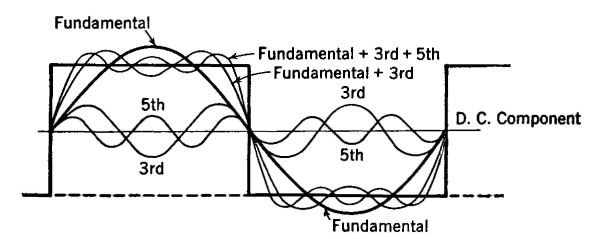| Electrical Communication is a free textbook on the basics of communication technology. See the editorial for more information.... |

|

Home  Telegraph Systems Telegraph Systems  Nature of Currents in Neutral, or Single-Current, Systems Nature of Currents in Neutral, or Single-Current, Systems |
|||||






|
|||||
Nature of Currents in Neutral, or Single-Current, SystemsAs mentioned in the previous section, the currents in a neutral, or single-current, system flow in one direction only and consist of a series of dots, dashes, and spaces. When the telegraph key is closed, current is allowed to flow through the line operating the relay or sounder to the closed or marking position. When the key is opened, the armature of the sounder moves to the open or spacing position. If the line is short and the inductance, capacitance, and leakage are negligible, the circuit may be assumed to consist of resistance only. The current in such a circuit will be a series of rectangular code impulses. In practice, however, the circuits are long and have large amounts of inductance, capacitance, and leakage; also, the sending and receiving apparatus have considerable inductance and capacitance. These factors distort the signals and may cause them to deviate considerably from rectangular impulses.
A long succession of uniform dots and spaces may be considered as being composed of an infinite number of sinusoidal waves superimposed on a direct-current component. Pure rectangular waves as in Fig. 3 consist of the fundamental and a complete series of odd harmonics, the equation being
where I is the maximum value of the rectangular current wave. With hand operation a Morse operator can send an average of about 30 words, of 5 letters and one space, per minute. This corresponds to a basic frequency of about 12 cycles per second.3 An expert operator can send 50 words per minute, corresponding to 21 cycles per second.3 If "square" waves are assumed and if all frequencies up to and including the third harmonic are transmitted, it is evident from Fig. 3 that a Morse circuit can be operated over a channel that will pass from zero to about 100 cycles.4 A rectangular telegraph current wave will operate the receiving device in a quick and decisive manner with little distortion, and from this standpoint is desirable. Such a wave, however, would cause considerable crossfire (page 331) and thump (page 339) in paralleling communication circuits, because the high-frequency harmonic components would cause greater induction. In practice, series inductance either with or without shunted capacitance is often inserted at the transmitting end to eliminate the higher harmonics in the telegraph signals - in other words to "round off" the otherwise rectangular signal waves and produce currents as in Fig. 4.
|
|||||
Home  Telegraph Systems Telegraph Systems  Nature of Currents in Neutral, or Single-Current, Systems Nature of Currents in Neutral, or Single-Current, Systems |
|||||
Last Update: 2011-05-30




